
Fencing - Quick Guide
Fencing - Overview
Fencing is a game in which is played between two fencers. Both the fencers use swords to attack the opponent and to defend self. There are some rules and regulations which the players have to follow while attacking or defending. Three different groups of weapons are used in fencing and each weapon has its own set of rules and regulations. Most of the fencers select one so as to specialise in using any one of these weapons.
This is a sword exerting game where two fencers try to touch each other with the tip of their sword. The main objective of this game is to touch the other player and score enough points required to win the game before the opposite player scores points. There are different approved target zones based on the weapon used and players have to touch those target zones to score points.
A Brief History of Fencing
Fencing was initiated in the 12th century though the oldest surviving manual on swordsmanship dates around 1300. In ancient days in Rome and Egypt, fencing was quite popular and was an essential part of life in the form of swordsmanship. In the middle age, i.e. around 1400, the use of armours was introduced in order to make the game more defensive and interesting.
Spain was the first one to practice fencing. Several books related to fencing have been written by Spanish authors. Modern fencing was originated in the 18th century in the Italian school of fencing and under their influence. It was later on developed by French school of fencing.
Participating Countries
Modern fencing was originated in Italy. It is also popular in other countries. Besides Italy, other countries like France, Russia, South Korea etc, also participate in the competitions of fencing. Presently, more than 50 countries around the globe are participating in different fencing competitions and tournaments.
Fencing - Equipment
In this game, the players have to touch each other through the tip of the sword, so playing equipment and safety equipment are needed to play this game. In this chapter, we will discuss about the equipment needed to play this game.
Clothes
Tough cotton or nylon and fabrics like dyneema are used to make the outfit of fencing players. These are added to high level outfits mostly in jackets, breeches, underarm protector, lame and bib of the mask.

Jacket
These jackets are entirely designed for fencing and are closely fitting with a special strap that goes between the legs and are used to provide adequate protection to the fencers. In case of sabre fencing, a different kind of jacket is used which is cut along the waist. A small gorget of folded fabric, i.e. a defensive material is sewn around the jackets collar to prevent opponents blade to slip in between the mask and jacket.
Plastron
This is an underarm protector that is worn below the jacket and is used to provide extra protection to the sword arm, belly and some parts of the fencers back side. This is used as a last line of defence between your body and a broken weapon. Extremely strong to penetrate, these are mostly made of Kevlar.
Mask
The fencing mask can support 12 kg on the metal mesh. A bib, which is made of ballistic materials or Kevlar, is included in the mask to protect the neck area which supports 350 Newtons of penetration resistance on the bib. The official regulations dictate that the mask must withstand 25 kg on the mesh and it must have 1600 Newtons of penetration on the bib.
Every weapon has its unique masks. There are Foil masks, Sabre masks and three weapon masks that can be used for any of the fencing weapons. The mask must be free from tears, holes or dents. Masks with transparent visor are prohibited in Foils and Epee fencing but are kept as optional for sabre fencing.

Breeches and Knicker
These are short trousers that ends just below the knee. They are required to overlap 10cm of the fencing jackets and are equipped with braces.
Gloves
One glove is used for the weapon arm and is stretched around half of the forearm. A gauntlet in the glove prevents blade from going in to sleeves and causing injury. Easier to wear, gloves also protect the weapon hand and also provide good grip.
Chest Protector
It is made of plastic or aluminium and is mandatory for the female fencers and is used as a chest guard. Even for males, chest guards are there but they are primarily used by the trainers or instructors rather than the fencers who mostly get hit during the training. Chest protectors are more famous in foil fencing and act as a guard against hits.
Shoes and socks
The shoes used in fencing specially designed with flat soles as well as other changes in the inside of back foot or the heel of front foot to avoid problems during lunging and they keep the fencers foot in place when he lunges. The socks used in fencing should cover the parts that are not covered by the knickers and the knickers should overlap them.
Weapons
Three different kinds of weapons are used in fencing which are − Foil, pe and sabre. All three of them have different set of rules and strategies to play with. Most of the players usually choose to play with and specialize in any one of these weapons. The FIE blades or official blades are made of Maraging steel, which is used to resist breaking.
Foil
It is a light thrusting weapon with a maximum weight of 500 grams. Mainly designed for thrusting, it is very thin with a foiled or blunted tip. These are flexible enough to bend upon touching the opponent in order to avoid injuries. The foil has a small circular hand guard that serves to protect hand from direct stab. As hand is not a primary target in fencing, hand guard is mostly used for safety

In foil fencing, a foil may target the torso (including back), neck and groin but not arms and legs. All the foil fencers wear a jacket that covers all the targeted areas, which is also called a lame. Touches are scored only with the foil tip. Hits with the side of the blade (off target touch) dont count but dont halt the action whereas hits on outside of the target area are not counted as scores and it also does stop the action.
Only one touch can be scored by either fencer at a time. The referee has to differentiate offence and defence. According to that, the fencer who made an offence, i.e. started the attack first against the fencer, who made a defence, gets the point. This rule is not followed in Epee fencing.
Epee Fencing
In French, Epee means sword. Epee has a v- shaped blade and also a thrusting weapon like Foil, but a little heavier in weight and stiffer than Foil, with a maximum weight of 770 grams. The hand guard in case of Epee is a large circle that is extended towards the pommel in order to guard hand effectively, which is a valid target in case of Epee. Epee fencers uniform doesnt include a lame.
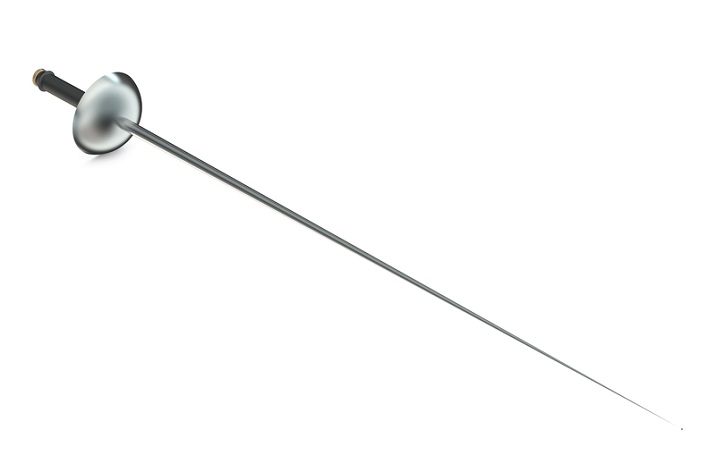
In case of Epee, the entire body is the valid target. In case of Epee, all hits have to be made with the tip and hits with the side of the blade are not counted as scores and they dont even halt the action. As the entire body is target here, so there is no off-target touch in case of Epee except when the fencer hits the floor and set of the electric tone.
In case of Epee, there is no right of way rule to decide score in case of simultaneous hits by both fencers. Here both fencers are allowed scores, but in case of a tie up at the end of a match, all the double touches scored, are considered null or void.
Sabre
A sabre has similar weight and length as a foil. It is a thrusting weapon as well as a cutting weapon with a weight of 500 grams. The hand guard in case of sabre is extended from pommel to the base where the blade is connected with the hilt. During the game, the guard is generally kept outwards in order to protect the hand from touches.
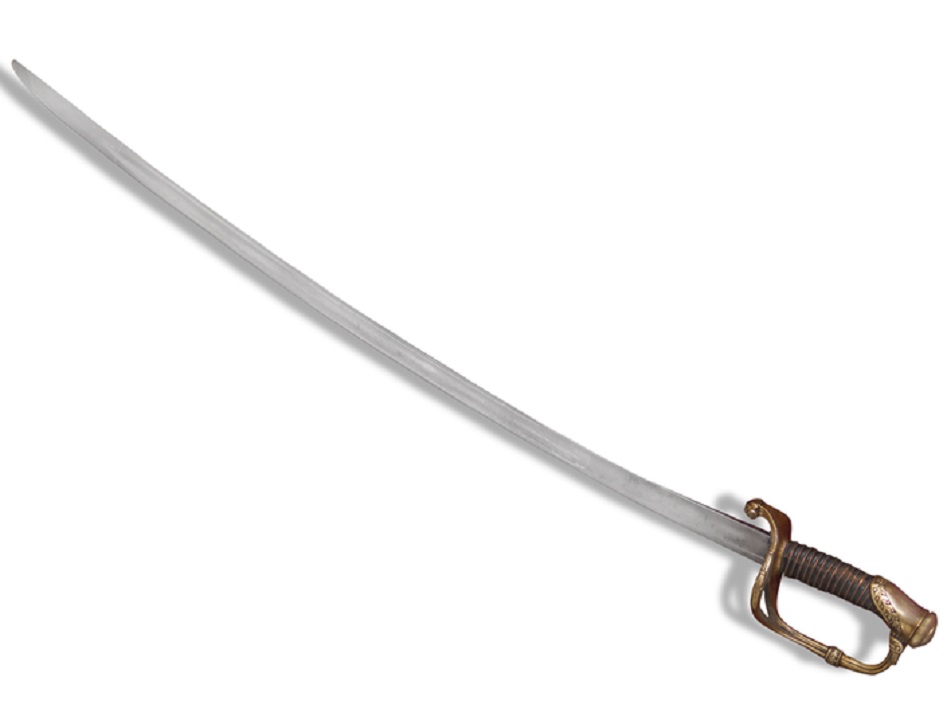
In case of sabre, hit with weapon point or by the side of the weapon, both are valid. Hits outside the target area are not valid. But off-target touch doesnt stop the action. During simultaneous touching, referee takes the decision using right of way rule. The mask is different and it includes a metallic covering as head is a valid target in this fencing.
Fencing - How to Play?
In case of fencing, techniques are divided into two categories: offensive and defensive. Some techniques are there which can be put in both categories. Certain techniques are known as aggressive techniques and are meant to land touches on the opponent fencer while holding the right of way (for foil and sabre), are called offensive techniques. Other techniques are used to protect against a hit or for defence, are called as defensive techniques.
Offensive Techniques
The offensive techniques used in this game are as follows −
Attack
It is a basic fencing technique and is also called as thrust where a fencer extends his arm to declare attack against the opposition and try to touch the other fencer in valid area. In case of sabre, attacks can be made with a cutting action.
Riposte
It is the attack by the defender after the attacker has attacked and has been parried. After the parry, a defender has some opportunity to attack back and take right of the way.
Feint
It is solely meant for provoking a reaction from the opposing fencer.
Lunge
In this type of attack, a player performs a thrust by slight kicking and extending the front leg. After that he can propel the body forward by back leg.
Beat attack
In this attack the attacker tries to gain the opportunity to hit the target area in case of foil and sabre. In case of epee, the attacker disturbs the intention of the other player and hits the target.
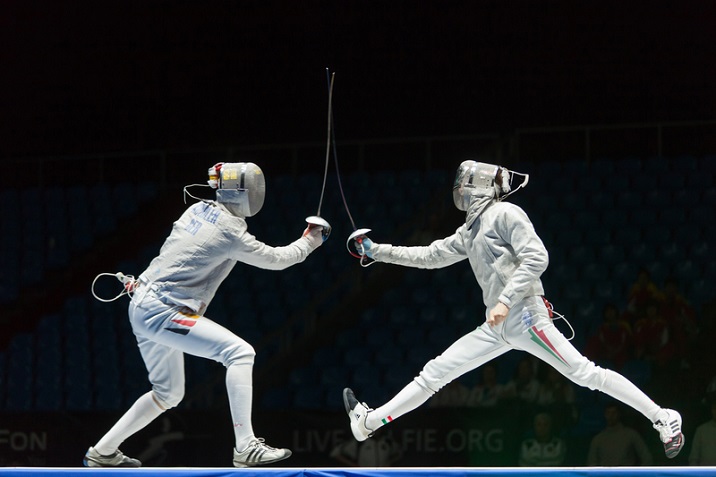
Disengage
Disengage is an attacking technique where the attacker begins attacking from one direction and then suddenly moving the point down in a semicircle to attack from a different direction. It is effective in breaking the defence of the opponent and hitting the target.
Continuation of attack
It is a typical Epee action to make second attack after the first attack is parried, which is mostly achieved by attacking while changing the line of attack.
Remise
It is a typical foil/sabre technique in which the opponent is attacked after the first attack is parried by the opposing fencer. Mostly it is considered as losing right of way and riposte is always scored instead of remise.
Flick
This is a technique which is exclusively for foil fencing, where the attacker has to take advantage of the bending quality of the foil blade by whipping it in such a way that it bends over and strikes the opponent with its point.
Defensive Techniques
The defensive techniques of Fencing are as follows −
Parry
It is a basic defence technique where the fencer has to block the opponents weapon while he is attacking or preparing to attack by deflecting the attackers blade to hit the valid area(Epee) or prevent him from scoring a right of way(sabre and foil). This is mostly followed by a riposte from the defender.
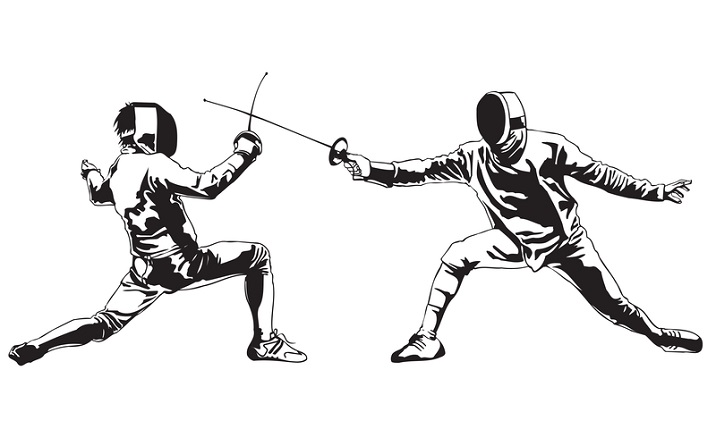
Circular parry
It is done by twisting the sword in a circular way in order to get a hold of the attackers weapon tip and mostly followed in order to deflect a disengage made by the attacker.
Counter attack
A basic fencing technique of attacking your attacker while generally moving back from the oppositions attack direction. It is mostly followed in Epee fencing and is scored against the opponents arm.
Point in Line
It is achieved by extending arm and weapon towards the attackers target area. In case of foil or sabre, it gives one priority if it is extended before the attacker advances lunges distance away. When meant for a defensive hit, the attacker must disturb the weapon to retake priority. If the attacker fails to disturb it, then it turns in to a counter attack if the attacker could not manage the right of way. In case of Epee as there is no right of way, the defence may score a double touch and earn one hit to each fencers.
Fencing - Rules
Playing Environment
A fencing match takes place on a strip or piste. The width of the piste should be between 1.2 to 2 meter and height should be 14 meter long. Two meters on either side of the midpoint, there are two lines called en-garde lines where the fencers start before the bout. There are also two warning lines on two meters on either end of the strip to let a fencer that he/she is out of the space while retreating off the strip scores one point to the opponent.
Participants
Three people are involved in the game: two fencers and the referee. The referee stands at the side of the strip. Prior to the game, the players must salute each other denying which may lead to disqualification of the fencer. After the salute, the referee calls Engarde while the players get ready with placing their front foot behind en-garde line and their weapons, in case of Foil, in sixte line, which is also called the on guard position. After that the referee calls for ready? and then play, and the bout starts.
A referee may halt a game during a hit, penalty or when the players go in to passivity by calling Halt! .Once the point is awarded after a hit, the fencers get back behind the engarde line and the game is again resumed by the referee.
Team Events
In case of team events, a team of fencers comprises of four players where the 4th player acts as an alternate, but once added in the game they cant leave again and the opposition must know about the substitution before the first round. Total nine matches are played between them each comprising of 5 points where each match has duration of 3 minutes. In a match, games are played as one on one, where a player from a team competes with another one from the opponent team. The team maximum score wins the bout. In case of tie, tie breaker rounds take place.
Penalties
Three different kinds of penalty cards or flags are there in fencing. A fencer is penalised with a yellow card is warned but no action is taken. If a fencer is awarded with a red card, then one point is awarded to the opponent. In case of black card, a player gets expelled from the tournament or suspended from future games in case of serious offences.
Different kinds of offenses are there. Group one offence includes delaying the bout or making bodily contact with the opponent. Such a player is awarded with a yellow card. Group two offence includes violence or offensive behaviour. Such a player is awarded with a red card. The Group three offence includes disturbing the order of the bout like intentionally falsifying inspection marks on equipment. Such a player is awarded with a red card. Other group 3 offences include serious offences like doping or cheating or failing to follow the protocols. Such a player is awarded with a black card.
Fencing - Wheelchair
It is a kind of fencing sports for athletes with disability. It is govern by the International Wheelchair and Amputee Sports Federation which is a federation of International Paralympics Committee. Fencing is one of the sports in the Paralympics games that takes place once in every four years in different countries. The first Wheelchair Fencing took place in 1950 and it has been a part of Paralympics since 1960. The game takes place in special frame to hold the wheel chairs stable.
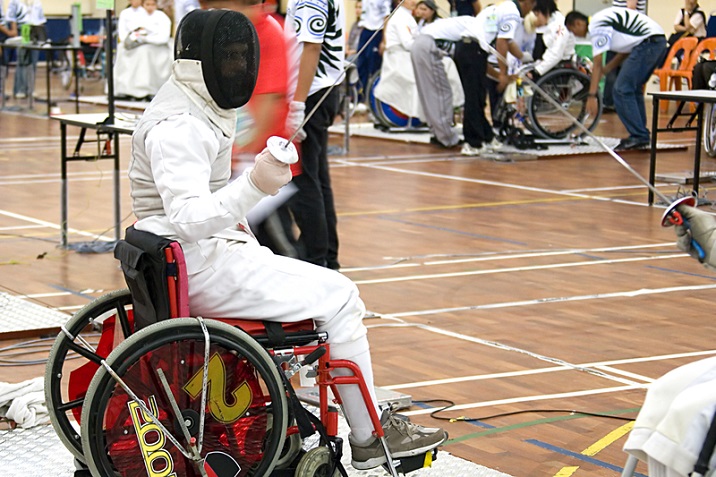
In case of wheel chair fencing, the fencers go for five touching, but they cannot advance or retreat. Here also fencers use three kind of weapons that are Foil, Epee and Sabre. The game involves techniques like ducking, making half turn, leaning forward and backward to avoid being touched. However all touches must be scored without the fencer rising from his seat.
In case of foil event, the fencers are permitted to hit only the trunk part while in case of sabre and epee, the fencers are allowed to touch any part of the body above waist.
The duration of game is maximum four minutes in preliminary stages. If a fencer scores five touches or more in that duration, he is touted as the winner. In competitions, first rounds are of nine hits while the direct elimination rounds are of fifteen hits. In case of tie, a sudden death bout of one minute is held where the fencer scoring the first valid touch is declared as the winner.
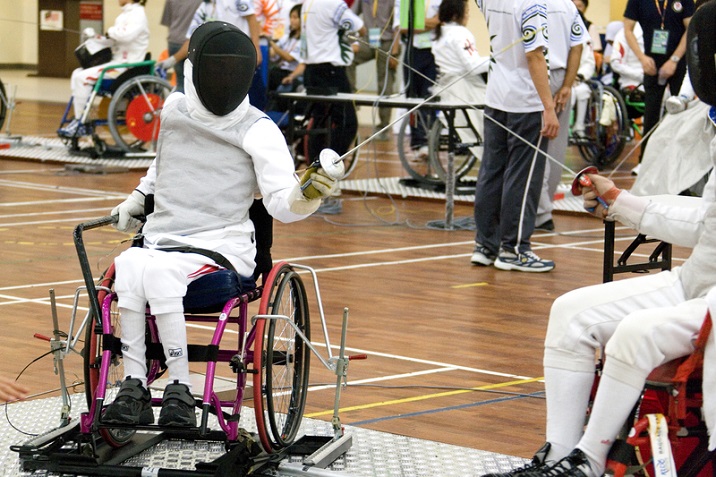
Different kinds of classifications are there in wheelchair fencing based on the impairment −
Category A for fencers who are regarded as class 3 or class 4 fencers. They have a fair sitting balance with or without support of their lower limb.
Category B is for fencers who are regarded as class 2 fencers. They have a fair sitting balance as well as unaffected fencing arms. They must have incomplete tetraplegia with fencing arms that are minimally affected.
Category C is for fencers who are disabled in all four limbs and are not included in Paralympic games.
Fencing - Champions
The Fdration Internationale d'Escrime (FIE) or the International Fencing Federation is the governing body of the Olympic fencing. It also assists the International Olympic Committee in the organization of fencing events at Summer Olympics. The head office of FIE is at Maison du Sport International in Lausanne, Switzerland. The FIE is composed of 145 federations, each of which represents the Olympic fencing committee of that country.
The World Fencing Championship is an annual fencing competition organized by FIE and is the second most prominent fencing competition after Olympics. The Fencing World Cup is an international fencing competition held by FIE. For the ranking of an individual fencer, the first top five results from Fencing world cup, as well as Fencing championship results, Olympic game results and zonal championship results are also taken in to account.
Let us now discuss briefly about the careers of some famous Fencing players who have gone on to become the champions of this sport.
Stanislav Pozdnyakov
Stanislav Pozdnyakov was born on 27th September 1973 and belongs to Russia. His weapon is sabre and he is right-handed. He won four golds in Olympic Games out of which one is from individual while rest are from team event.
In World Fencing Championship, he won ten golds, five silvers, and two bronzes. After retiring from the sport, he is now continuing as one of the official in FIE.
Alexandr Romankov
Alexandr Romankov was born on 7th November 1953 and belongs to Soviet Union. His weapon was foil and he was left-handed. In 1976 Olympics, he won a silver in foil individual event. In 1980 Olympics, he won one silver in team event and one bronze in foil individual.
In 1988 Olympics, he won a gold in foil team event and one bronze in foil individual event. He won World Cup in 1974 and 1976. He was world champion in individual events from 1977 to 1983 and in team events from 1981 to 1989. He was also world champion in both individual and team events in 1974, 1979, and 1982.
Pavel Kolobkov
Pavel Kolobkov was born on 22nd September 1969 and belongs to Russia. His weapon is epee and he is right-handed. He won one gold, one silver and one bronze in Olympic Games in individual events and one silver and two bronzes in team events.
In World Fencing Championships, he won four golds, one silver and two bronzes in individual events and one silver and one bronze in team events. In European Championships, he won two golds, three silvers, and four bronzes in individual events and one silver and one bronze in team events.
Christian dOriola
Christian dOriola was born on 3rd October, 1928 and belongs to France. His weapons were foil and epee and he was right-handed. In Olympics, he won two golds, and one silver in individual events and two golds and one silver in team events.
In World Fencing Championships, he won four golds and one silver in individual events and four golds and two silvers in team events. He died at the age of 79 in France.
Jerzy Pawlowski
Jerzy Pawlowski was born on 25th October 1932 and belongs to Poland. His weapon was sabre and he was right-handed. In Olympics, he won one gold and one silver in individual event and two silvers and one bronze in team events.
In World Fencing Championships, he won three golds, four silvers, and one bronze in individual events and four golds, two silvers, and four bronzes in team events. He died at the age of 72 at Poland.
Valentina Vezzali
Valentina Vezzali was born on 14th February 1974 and belongs to Italy. Her weapon is foil and she is right-handed. In Olympics, she won three golds, one silver, and one bronze in individual events and three golds and one bronze in team events.
In World Championships, she won six golds, two silvers, and four bronzes in individual events and ten golds and five silvers in team events.
In European Championships, she won five golds, three silvers, and two bronzes in individual events and eight golds, one silver and one bronze in team events.
Yelena Jemayeva
Yelena Jemayeva was born on 30th March 1971 and belongs to Azerbaijan. Her weapon is Sabre and she is right-handed. In World Fencing Championships, she won two golds, one silver and four bronzes in individual events and three bronzes in team events.
In European Championship, she won one gold and one bronze in individual events and two bronzes in team events. She also participated in 2004 Summer Olympics but lost in quarterfinals.
Sofiya Velikaya
Sofiya Velikaya was born on 8th June 1985 and belongs to Russia. Her weapon is Sabre and she is right-handed. In World Fencing Championships, she won two golds, one silver and one bronze in individual events and five golds, one silver and two bronzes in team events.
In European Championship, she won four golds, and three silvers in individual events and five golds and one silver in team events. In 2012 London Olympic Games, she bagged one silver. She has also won a silver in 2016 Rio de Janeiro Olympics. In both the Olympics, she won the medals in individual events.
Li Na
Li Na was born on 9th March 1981 and belongs to China. Her weapon is epee and she is lefthanded. In World Fencing Championships, she won one gold in individual event and one gold and one bronze in team events.
In Olympic Games, she won one gold and one bronze in team events. She also participated in 2008 Summer Olympics and earned fourth place. She retired in 2013.